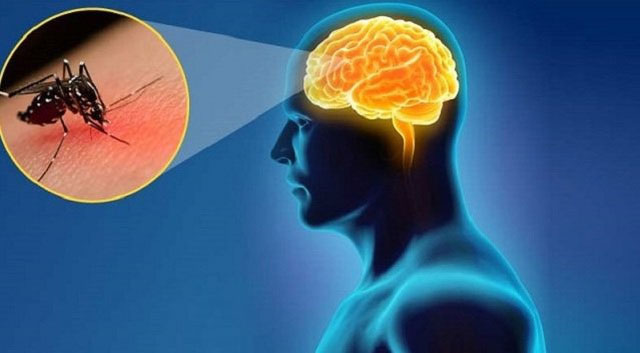Early signs of Japanese encephalitis in children
Japanese encephalitis can lead to fever, headache, mental disorders, spasms in the neck and spine, and muscle weakness.
How dangerous is Japanese encephalitis?
According to experts' warning, June is the time when the Japanese encephalitis outbreak is the strongest in our country. Japanese encephalitis is a dangerous disease, common in children under 15 years old . Patients with Japanese encephalitis have a high mortality rate (world statistics, death rate up to 30%), if treated, the risk of the disease leaving permanent neurological sequelae also up to 30-50%. The most common neurological sequelae include: dementia, cognitive impairment and language skills, mental problems or the possibility of recurrent seizures.

Japanese encephalitis does not currently have antiviral drugs.
According to Assoc. Prof. Dr. Bui Vu Huy, Former Head of Pediatrics Department, National Hospital of Tropical Diseases, Japanese encephalitis does not currently have antiviral drugs. The treatment of Japanese encephalitis is only a symptomatic treatment. In general, the care and treatment of Japanese encephalitis patients is very hard. Despite the Ministry of Health's treatment regimen, dealing with each specific situation such as coma, convulsions depends on the situation of the patient and requires doctors to urgently, use the right dose of the drug. .
'There are severe cases of patients who need to be ventilated, then there is a 24-hour medical team, which is very expensive. Even when the patient is awake, the condition is stable, the remedy to leave sequelae, typically paralysis, is not easy ' - this expert emphasized.
According to former Deputy Head of Pediatrics, Central Hospital for Tropical Diseases, the time of finding and treating the disease is one of the decisive factors to the effectiveness of treatment for Japanese encephalitis. The earlier the patient is admitted to the hospital, the easier it is to treat because the more convulsive the seizure is, the deeper the coma, the more serious the damage to the nervous system will result in the further sequelae.
Recognize the early warning symptoms of Japanese encephalitis for prompt treatment
High fever, convulsions, coma are the three most typical signs of Japanese encephalitis. However, according to Assoc.Prof. Dr. Bui Vu Huy these signs usually appear only from the 3rd day onwards and until now, it is late: 'There are cases of malignant encephalitis in only 24 hours, patients coma seizures and stop breathing, even mechanical ventilation at that time was no longer effective, because there was brain necrosis leading to brain death '.

High fever, convulsions, coma are the three most typical signs of Japanese encephalitis.
Therefore, in order to detect the disease at an early stage, families need to pay special attention to the health status of the child, especially in the current epidemic peak. Children should be examined at the nearest health facility if the following symptoms appear:
- Unusual fever, coughing up steadily;
- Babies fussy for no apparent reason;
- Diarrhea, vomiting, headache;
- Systemic weakness, more severe than hemiplegia.
Prevention of Japanese encephalitis as recommended by experts
For Japanese encephalitis, proactive disease prevention is the best solution. 'Our country is a tropical country. Therefore, infections as well as insect-borne infections are very common. Therefore, everyone needs to have a disease prevention plan ' - Assoc.Prof. Dr. Bui Vu Huy recommends.

Need enough injections as directed, to ensure effective prevention.
Here are 5 principles to prevent Japanese encephalitis in particular and infectious diseases in general, as directed by experts:
- Always pay attention to improving health, eating and drinking well, periodic health examination, if signs of abnormalities should promptly go to medical facilities.
- Ensure personal hygiene, especially in washing hands.
- Full immunization of vaccines. Need enough injections as directed, to ensure effective prevention.
- Sanitation, kill mosquitoes, apply measures to prevent mosquito bites.
- Regularly follow instructions from the Ministry of Health, as well as preventive medicine centers.
- Early signs of Japanese encephalitis
- Prevention and treatment of Japanese encephalitis
- Many children with meningitis enter the hospital
- Japanese encephalitis on the top of the epidemic
- Decipher the secret of Japanese encephalitis in the 1930s
- Many children are hospitalized with meningitis
- Watch out for Japanese outbreak of encephalitis
- Signs of differentiation of encephalitis with meningitis
- 200 Indian children die from encephalitis
- Hanoi vaccines against Japanese encephalitis for free
- The North started season inflammation of the brain and meninges
- Warning for acute encephalitis with Coxsackie virus
 13 causes of non-itchy rash
13 causes of non-itchy rash How the mouse with human ears changed the world?
How the mouse with human ears changed the world? The truth about 'fried rice syndrome!
The truth about 'fried rice syndrome! What is dental implant?
What is dental implant?